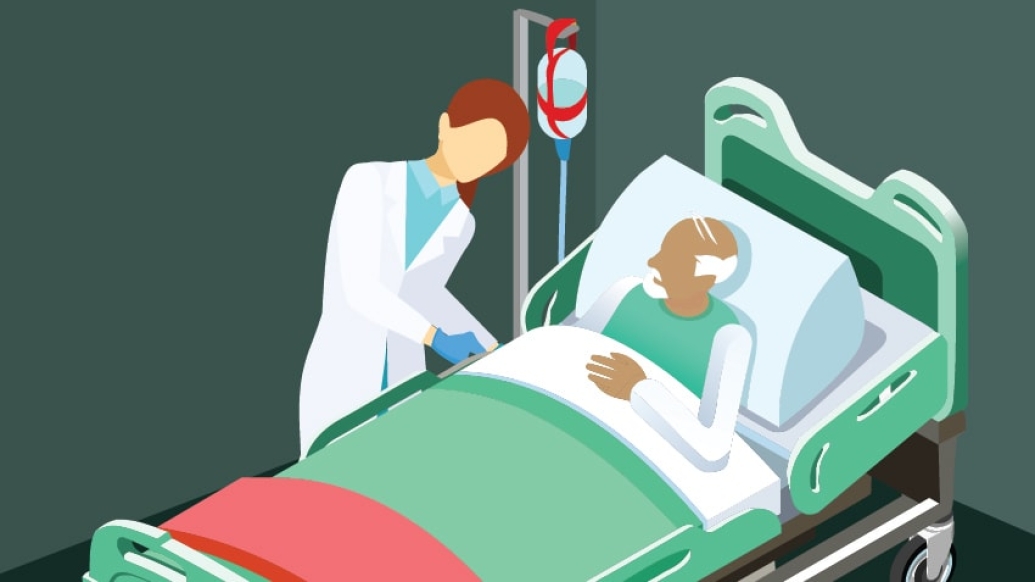Patients are three times likelier to contract the dangerous infection when a hospital is at midlevel occupancy, a new way of tracking the data finds.
7:00 AM
Author |

Hospitals spend a lot of time and effort to protect their patients from developing new infections — especially dangerous ones that can pose a greater health threat than whatever brought that person in for care.
LISTEN UP: Add the new Michigan Medicine News Break to your Alexa-enabled device, or subscribe to our daily audio updates on iTunes, Google Play and Stitcher.
These facilities carefully track hospital-acquired infections. And they even get paid more by the Medicare system if lower infection rates are achieved.
But this massive effort has been missing a key element, according to University of Michigan and Rand Corp. researchers. None of the tracking measures take into account how full a hospital was when the patient acquired the infection — that is, what percentage of available beds were occupied and how thinly stretched the staff was at the time.
In a new paper in the Journal of Hospital Medicine, researchers share the first results from using the approach on real-world data related to the digestive tract infection known as Clostridium difficile, or "C. diff."
While it might seem obvious that a fuller hospital would mean higher risk of C. diff among its patients, the study finds the opposite to be true.
A patient's infection risk was highest when the hospital was in the middle range of occupancy on the day the patient was admitted.
When researchers looked at average occupancy over the course of a patient's stay, the risk of C. diff infection was more than three times higher when the hospital was between 25 percent and 75 percent full, compared with less than 25 percent or more than 75 percent occupancy.
"The theory that infection rates will go up with occupancy, because of staff cutting corners with steps like hand-washing, may seem logical but this model shows it's not as simple as that," says Mahshid Abir, M.D., M.Sc., the study's lead author who also leads the U-M Acute Care Research Unit and is a member of the U-M Institute for Healthcare Policy & Innovation.
It has led her team to develop an approach that they hope will lead to more uniform tracking of this important factor in patient safety.
Our initial results indicate a complex relationship between hospital occupancy and outcomes, and merit further evaluation, including collection of hospital occupancy data by infection control officers.Mahshid Abir, M.D., M.Sc.
Shifting measurement methods
The study used data from 558,829 patient discharges at 327 hospitals across California between 2008 and 2012. It focused on patients who had come to the hospitals' emergency rooms seeking care for a heart attack, heart failure or pneumonia.
In all, 2,045 patients developed a C. diff infection after they reached the hospital. The researchers adjusted for many factors, including age, gender, income, education and other factors that differed among patients.
MORE FROM THE LAB: Subscribe to our weekly newsletter
The data for the study came from California's Office of Statewide Health Planning and Development Patient Discharge Data set, which tracks hospital discharge records for all licensed general acute care hospitals in California. The study was done after the state instituted minimum nurse-to-patient ratios in 2006 to ensure nurse staffing was adequate.
Abir notes that the new approach to measuring hospital occupancy takes into account how many beds the hospital actually has open and staffed, rather than how many they're licensed to operate.
This more precise approach, calculated by looking at census data for each hospital, could be used to track many kinds of patient outcomes in relation to occupancy.
Which is why the study's researchers approximated a hospital's actual bed capacity by looking at the maximum daily census in a four-month period around each day that they examined. This allowed them to factor in changes in bed availability — when hospitals close units, for instance, or have lighter staffing due to seasonal variation.
The team broke occupancy into four levels: low (0 to 25 percent), two classes of moderate (25 percent to 50 percent and 51 percent to 75 percent, respectively), and high (76 percent to completely full).
Abir and her colleagues note that other studies in Europe and beyond have shown a higher rate of hospital-acquired infections when hospitals are very full — but those studies used licensed bed counts and didn't factor out infections that the patient already had upon arrival.
"Our initial results indicate a complex relationship between hospital occupancy and outcomes, and merit further evaluation," including analysis of hospital protocols that might be triggered or modified when a hospital is in high or low occupancy, Abir says.
Implications for future treatment
Abir and her co-authors call for collection of hospital occupancy data by infection control officers so that more precise measurements of occupancy can be used when examining hospital-acquired infections and other preventable threats to patient health and safety.
SEE ALSO: Predicting C. Diff Risk with Big Data and Machine Learning
"The impacts of emergency department crowding on patient outcomes have been studied extensively, but the effects of occupancy levels on inpatients have been neglected — despite the fact that a crowded ED is often a function of high inpatient occupancy," she says. "Some hospitals may be implementing operational factors during high occupancy that improve HAIs; we need to study what those are."
The team is also looking at the connection between hospital occupancy and patient mortality, and other outcomes, as well as the impact of the California nurse staffing ratio requirements.
More information about the effort is available here.

Explore a variety of healthcare news & stories by visiting the Health Lab home page for more articles.

Department of Communication at Michigan Medicine
Want top health & research news weekly? Sign up for Health Lab’s newsletters today!





